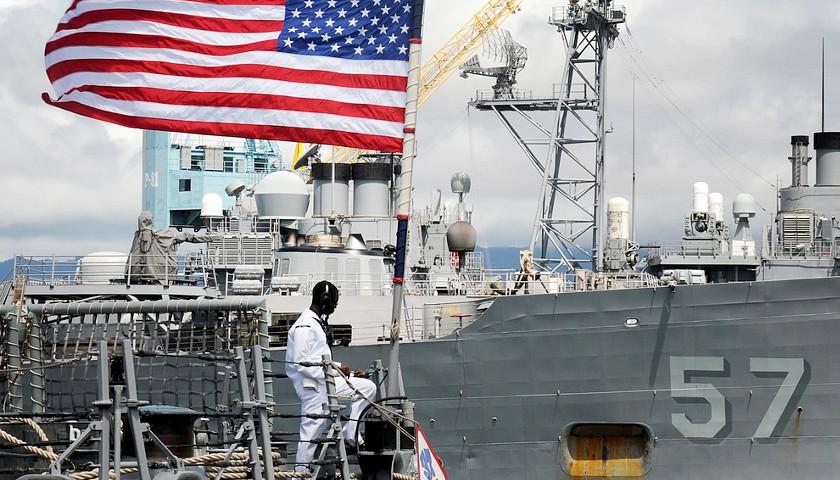by Micaela Burrow and Mary Lou Masters
Several 2024 Republican primary candidates laid out their plans to strengthen and increase the size of the U.S. Navy if president in statements to the Daily Caller News Foundation after the third GOP debate moderators pressed contenders on the topic.
Some Republican candidates have criticized President Joe Biden for allowing the Navy to atrophy in recent years as China’s military threat to the U.S. grows, pledging to strengthen the fleet should they become president in comments to the DCNF. The 2024 hopefuls explained how they would overcome weaknesses in the industrial base, recruiting and overall strategy to reverse the Navy’s decline.
“We have to have the ability to back up a strategy of denial of [Chinese President Xi Jinping’s] ambitions,” Florida Governor Ron DeSantis, a Navy veteran, said at the debate. “And if China is able to be the world’s leading superpower, that will affect you and your family in ways that are going to be very bad.”
 DeSantis’ plan, released in late October and reiterated at the debate, detailed his agenda to achieve 355 ships by the end of his first term and 385 ships by the end of his second term, while setting the U.S. on track for reaching 600 ships in 20 years.
DeSantis’ plan, released in late October and reiterated at the debate, detailed his agenda to achieve 355 ships by the end of his first term and 385 ships by the end of his second term, while setting the U.S. on track for reaching 600 ships in 20 years.
“A DeSantis administration will not wait until December in its final year in office, as the Trump administration did, before clearly stating that our Navy is not large enough to defend this nation’s interests. With ongoing innovation in this field, we will invest in both manned and unmanned platforms to achieve our strategic goals. We will look at scaling and front-loading investments in the first year within the budget reconciliation process to achieve longer-term savings, cut other spending, eliminate Democrat’s New Green Deal items, and more,” a spokesperson for the DeSantis campaign told the DCNF.
Getting to a larger fleet faster than the Navy’s current schedule — which is on pace to achieve a minimum of 319 ships by the 2050s — will require billions in new investments to improve decrepit shipyards, expand industrial capacity and increase sailors’ quality of life. It also requires harnessing Congress’ long term-support to sustain momentum post-presidency.
DeSantis would expand maintenance yards into non-traditional locations to extend the life of aging Arleigh-Burke class destroyers a decade longer than planned and bring semi-retired “ghost fleet” ships back to life during a first term, giving the industrial base time to ramp up production, the spokesperson said.
“Our day-one program to build the Navy the United States requires will send a clearly achievable demand signal to the industry, giving them the confidence to invest in the equipment and skilled employees to make it happen,” the spokesperson said.
The spokesperson added the campaign is assessing plans to add additional nuclear-certified drydocks and maintenance facilities, including new ways of doing public-private partnerships, to restore sustainment. The Navy currently is years and $1.8 billion behind on maintenance, according to the Government Accountability Office.
In recent years, the Navy has operated between 270 and 300 battle force ships, according to a Congressional Research Service report.
Conservative businessman Vivek Ramaswamy revealed his goal to increase the size of the Navy by 20% over the next three years at the debate.
“We don’t have a choice,” Ramaswamy told the DCNF.
However, he focused on smaller and cheaper ships, funded through money saved from reduced military commitments abroad.
“Many of the ships China builds are smaller and cheaper. The U.S. Navy, too, should be thinking about smaller, cheaper, more lethal ships,” he said.
“An aircraft carrier costs $13 billion and is a missile magnet. We’ve got to move away from those massive, hugely expensive platforms to larger numbers of smaller ships and submarines, including unmanned vessels. And we’ve got to arm all of them to the teeth: every ship has to be a shooter,” Ramaswamy told the DCNF.
Ramaswamy pledged to restore competition to the defense-industrial base and send clear signals to shipbuilding companies that “the U.S. Navy is open for business.”
Both Ramaswamy and DeSantis promised to restore a sense of duty and patriotism to overcome historic military recruiting challenges.
Former U.N. Ambassador Nikki Haley hasn’t called for increasing the size of the Navy, but instead pledged to modernize the fleet and other military operations to compete with China “with the focus of cyber, artificial intelligence and space” at the debate.
“Strong militaries don’t start wars, they prevent wars. President Haley will make it a priority to strengthen and modernize our Naval fleet,” Haley campaign spokesperson Ken Farnaso told the DCNF. “China is running circles around us and Joe Biden’s weakness on national security and have left our armed forces unprepared for action.”
The former ambassador criticized her fellow Republican presidential candidates on the debate stage for providing Hewitt with a specific number at which they’d increase the size of the navy.
“But the reason no one should give you a number, Hugh, on the amount of ships in the Navy is because in a few years our interest expense is going to be more than our defense budget. So no one can give you that number realistically without first tackling what’s happening with the financial situation,” Haley said.
Former New Jersey Gov. Chris Christie would begin expanding the Navy by “drastically” increasing the amount of nuclear submarines at the debate, and said “ships would come next,” he said at the debate, which his campaign pointed the DCNF toward upon request for comment.
“The nuclear submarines in this United States Navy is the greatest deterrent to Chinese aggression, and that is the first place I would go to increase American naval power,” Christie told Salem Radio Network’s Hugh Hewitt.
“And so as our first priority, we need to go directly to our nuclear sub program, Hugh, and we need to increase it drastically. That would be priority number one. Ships would come next,” he said.
Christie’s campaign also referred the DCNF to a previous Town Hall, where the candidate indicated leadership would be crucial. He pledged to appoint a secretary of defense capable of managing budgets for “big-ticket items,” like ships and submarines, in a responsible way.
Former Arkansas Gov. Asa Hutchinson, who did not meet the Republican National Committee’s criteria to make the second or third debate stage, called expanding the Navy “a strategic necessity” in comments to the DCNF.
“To address issues in ship construction, maintenance, and readiness, I will institute efficiency and acquisition reforms, reduce wasteful spending, and rebuild necessary manufacturing capabilities,” Hutchinson told the DCNF. “Further, investments in research and development, modernization of the nuclear triad’s submarine leg, and bolstering naval capabilities will be at the forefront of my defense strategy.”
The former governor said he would fix the Navy’s recruiting problems by ensuring military families are paid enough and deprioritize social engineering policies.
North Dakota Gov. Doug Burgum, who did not make the RNC’s third debate stage, has yet to directly address bolstering the Navy in his presidential campaign, but continues to call for modernizing the military to deter China.
“We’ve got to get innovation and American ingenuity and American entrepreneurship back into our defense industrial base,” Burgum said in a Hudson Institute foreign policy speech that was forwarded to the DCNF upon request for comment. “As China continues to modernize its nuclear forces, it’s time to seriously invest in our own, including production and scientific infrastructure.”
Former President Donald Trump has not indicated whether he would veer from the course set under his first term if he returns to the White House. The Trump administration released a 30-year plan for the Navy in 2020 that planned 316 manned battle force ships by 2026 and 405 manned ships by 2051, with $34 billion extra investments in shipbuilding alone.
The plan fully funded recapitalizing the U.S. Columbia-class ballistic missile submarine program, building up the defense base and adding about 150 unmanned vessels to the fleet.
The Navy’s proposed building and decommissioning plans in its latest budget request would see the fleet expand to 300 by the early 2030s and 319, 328 or 367 by 2053, depending on which course of action Congress authorized, according to the Congressional Budget Office.
The RealClearPolitics average for a 2024 national Republican primary, based on polls conducted between Oct. 27 and Nov. 14, indicates Trump is leading the field by 44 points, followed by DeSantis with 14.8 percent, Haley with 9.6 percent and Ramaswamy with 5.1 percent. Christie garnered 2.1 percent support, Burgum received 0.7 percent and Hutchinson has 0.5 percent.
– – –
Micaela Burrow and Mary Lou Masters are reporters at Daily Caller News Foundation.
Photo “USS Crommelin” by US Navy.





